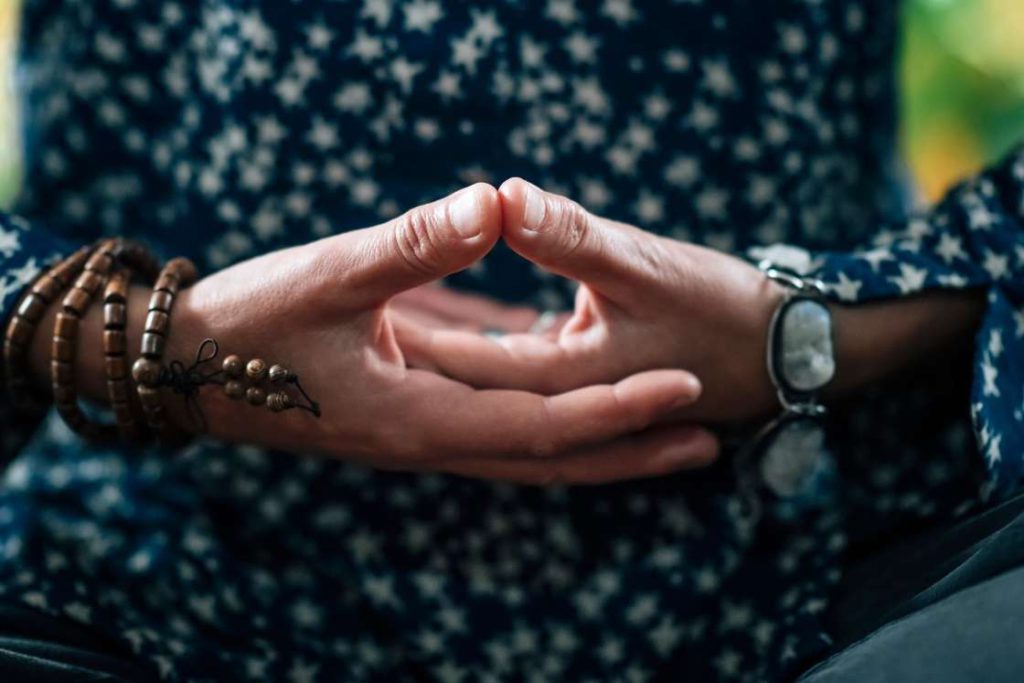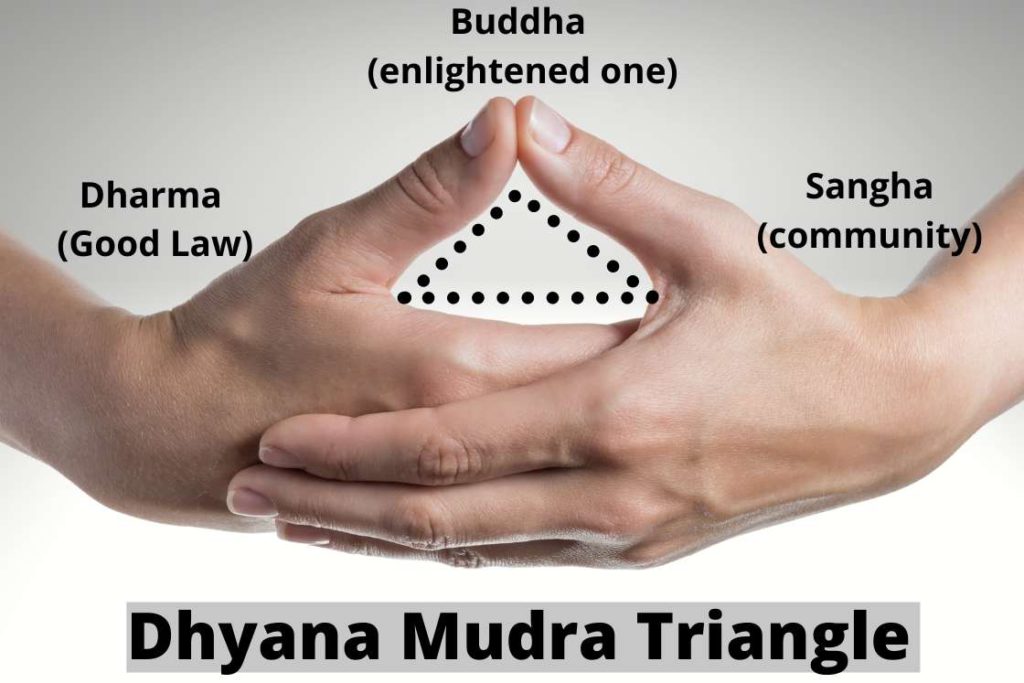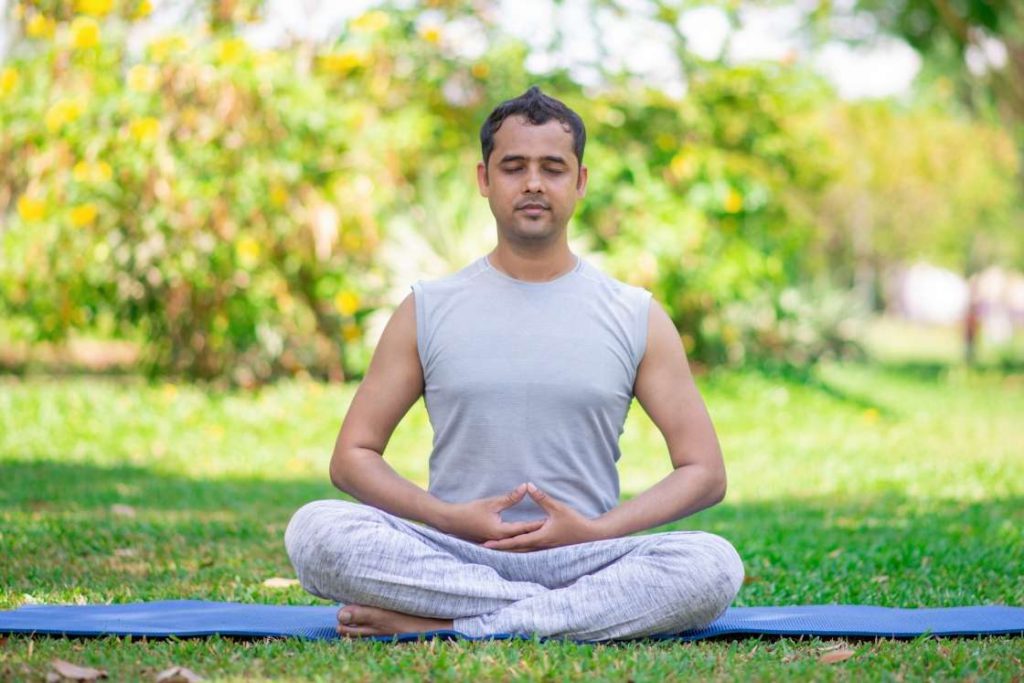
Dhyana isn’t an easy practice, so to assist the mind in this process, we practice Dhyana Mudra in yoga.
Dhyana Mudra is a popular hand mudra practiced during meditation to cultivate a sense of stillness of mind. It’s performed by placing the right hand over the left hand joining both thumbs tips diagonally.
This hand position helps in concentration and balances the dual nature of the mind because all five elements (Panch Tatva) meet together in it.
Tatra pratyaya-ikatānatā dhyānam
When there is an uninterrupted flow of thoughts and awareness, the Dhyana (meditation) arises.
~ Yoga Sutra of Patanjali [Chapter 3. Verse 2]
Meaning
Dhyana can be better understood by lighting up on its root terms ‘Dhi‘ and ‘Yana‘. The process of thinking or perceiving is called ‘Dhi‘ and ‘Yana‘ is the vehicle or practice of moving.
Formed by the words dhi and yana, Dhyana simply means the practice of properly think or perceive. Dhyana is one of eight limbs of yoga defined by Patanjali in Yoga Sutra.
Dhyana Mudra means a symbolic gesture of the state of mind in meditation that is depicted by the shape of a triangle made using hands and fingers.
For seated meditation, Gyan mudra is equally powerful as Dhyana Mudra but its effects on the brain are more calming and concentrated. It improves the quality of the mind to analyze and heal.
In Buddism, it is believed that it was practiced by Gautama Buddha during his meditation for the enlightenment process beneath the bodhi tree. However, before Buddha, Yogis practiced it to deepen the awareness in meditation.
Symbolic Representation

In the Buddist aspect, the triangle formed by joining thumb tips in Dhyana Mudra represents the three jewels of Buddhism: Buddha, Sangha (community), and dharma (Good law).
Besides, the right hand signifies knowledge, wisdom, and awareness and the left-hand represents the fantasy of existence in this world. When the right hand is placed over the left hand in Dhyana Mudra, it represents the dominance of knowledge and awareness over the illusions created by the world.
It also indicates the balance of dualities (solar and lunar energy, hot and cold, masculine and feminine energies) in the body. The whole gesture signifies the balance of all the elements and soul.
How to Do Dhyana Mudra

- Sit in a comfortable yoga pose such as Sukhasana or Padmasana. Make sure to keep your spine straight.
- Rest your left hand on the lap, palm facing upwards.
- Now, place the back of your right hand over the left-hand keeping fingers aligned to each other and stretched fully.
- Then, touch the tip of the thumbs of both hands together. This will form a triangle like structure with your hands and thumb.
- Now, gently close your eyes and take deep and slow breaths.
- Hold this hand position unmoved for at least 15 minutes. Once you are done, open your eyes slowly and then release the mudra smoothly.
Another Version
Dhyana mudra can be performed with a little variation. In this variation, the sitting posture is the same as above, but the position of the hand is slightly different.
- Curl the index finger to touch the tip of the thumb. It will make a circle like Gyan Mudra’s hands, do this with both hands simultaneously.
- Now, keeping the palms upwards, put left hand on the lap and right-hand palm over left hand’s palm (three fingers aligning to each other).
This is the alternate method of finger arrangement. The rest of the process remains the same as above.
Additional Tips
- While holding hands in Dhyan Mudra, one can Chant OM for better concentration. This will take awareness to a deeper level.
- It is best to perform this mudra in conjunction with the pranayama. This will increase the quality of meditation.
It is always preferred to perform this mudra in the morning time, with a fresh mind. However, If you face any difficulty performing it in the morning, you can perform it at any other hour of the day.
Try to perform Dhyana Mudra at least 45 minutes a day. If you feel it difficult to do in a single sitting, you can perform it 3 times a day (10-15 minutes each session).
Benefits of Dhyana Mudra
- As the name suggests, Dhyana mudra is specially designed to deepen the levels of meditation. Consequently, it is very helpful in the spiritual journey.
- While practicing this mudra, the left and right parts of the body, as well as the brain, are active. As a result, the practice of Dhyana Mudra brings balance between the left and right regions of the brain, as well as, the body.
- This mudra brings calmness and relaxation to the mind. Thus, it reduces negative emotions such as anger, anxiety, depression, stress, etc.
- Moreover, this mudra stimulates the Ida and Pingla Nadis (astral channel) of the body. This makes you attentive and focused.
- When one practices Dhyana Mudra regularly, it keeps him/her away from all the physical and mental illness.
Conclusion
Dhyana mudra is a powerful and transformative practice that aids in meditation, enhances concentration, and promotes inner peace. Its rich symbolism and historical significance make it a meaningful gesture for practitioners across various spiritual traditions. By incorporating dhyana mudra into your daily meditation routine, you can experience profound benefits and progress on your path toward enlightenment and equanimity.





Not quit right. There is no distinction between sexes.
Hello Ashish??
I noticed the illustration of the Dhyana Mudhra at the top has left hand over right palm and the instructions call for right hand to rest over left palm.. Please clarify.
Thank you.
Both hand positions are correct. Left hand over right palm is considered a good hand position of dhyana mudra for women. Which hand you put over another, accordingly right or left side energy dominates in our body. For women, the left side of the body is more dominant that’s why it’s kept over the right hand. Some illustrations used here may not be correct.